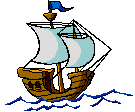How does a ship float?

Experiment based on one from The UnMuseum
How does a ship float?

Experiment based on one from The UnMuseum
What keeps a boat from sinking or a submarine from rising?Lesson: Understanding Buoyancy
Level: adaptable K-8Objective: Students will discover how ships are able to float.
Materials needed: Per lab group:
objects of various weight, size, material (i.e.: clay,
lego, toothpick, rock, safety pin, wooden block,
penny)
flat container (roasting pan is perfect)
waterObjective: Students will...
Engage in reading, writing, listening,
discussing and predicting.
Participate in scientific method.
Document findings.
Anticipatory Set: Students will be asked to think about :
Some ships are made of wood, wood
floats, this is easy to understand. What
What about ships made of heavier materials,
such as concrete or steel? These materials
are heavier than water, how do are they
able to keep afloat?A ship will float as long as it weighs less than the water it displaces. Ships can use materials in their hulls that are heavier than water as long as there is air within the ship. Since the air does not weigh as much as the water, the volume of the water is greater than the weight of the ship.
Class Activity: Teacher will hand out Scientific Method
Sheet to each student.
Students are given 15 minutes to read
through the sheet and ask questions.
Teacher will now hand out Buoyancy
Data Sheet to each student.
Students will be asked to read the data
sheet and follow its instructions.
Students will record findings.
Students may work with a lab partner,
but must show individual work.Key Terms: Students will...
learn the 7 steps to the Scientific Method.
be able to explain buoyancy (why something
is able or unable to float).Closure: Students will write out there findings in paragraph
form and turn in.
Arizona State Standards:
Mathematics:
1M-R3 Use manipulatives
1M-F7 A. Select appropriate techniques to facilitate computations
(e.g., mental estimation, paper and pencil, calculator and
computer methods) while solving problems and determing
the reasonableness of results.
B. Use appropriate techniques to faclitate computations
while solving problems and determing the reasonableness
of results.
2M-R2 A. Collect simple data.
B. Organize simple data.
C. Describe simple data.
2M-R3 A. Construct concrete displays of data.
2M-F3 A. Predict the likelihood of events and recognize that the
results of an experiment may not match predicted outcomes.
5M-F1 Demonstrate that a single object has different attributes that
can be measured in different ways:
A. Length
B. Mass/ weight
C. Time
D. Temperature
E. Area
F. Volume